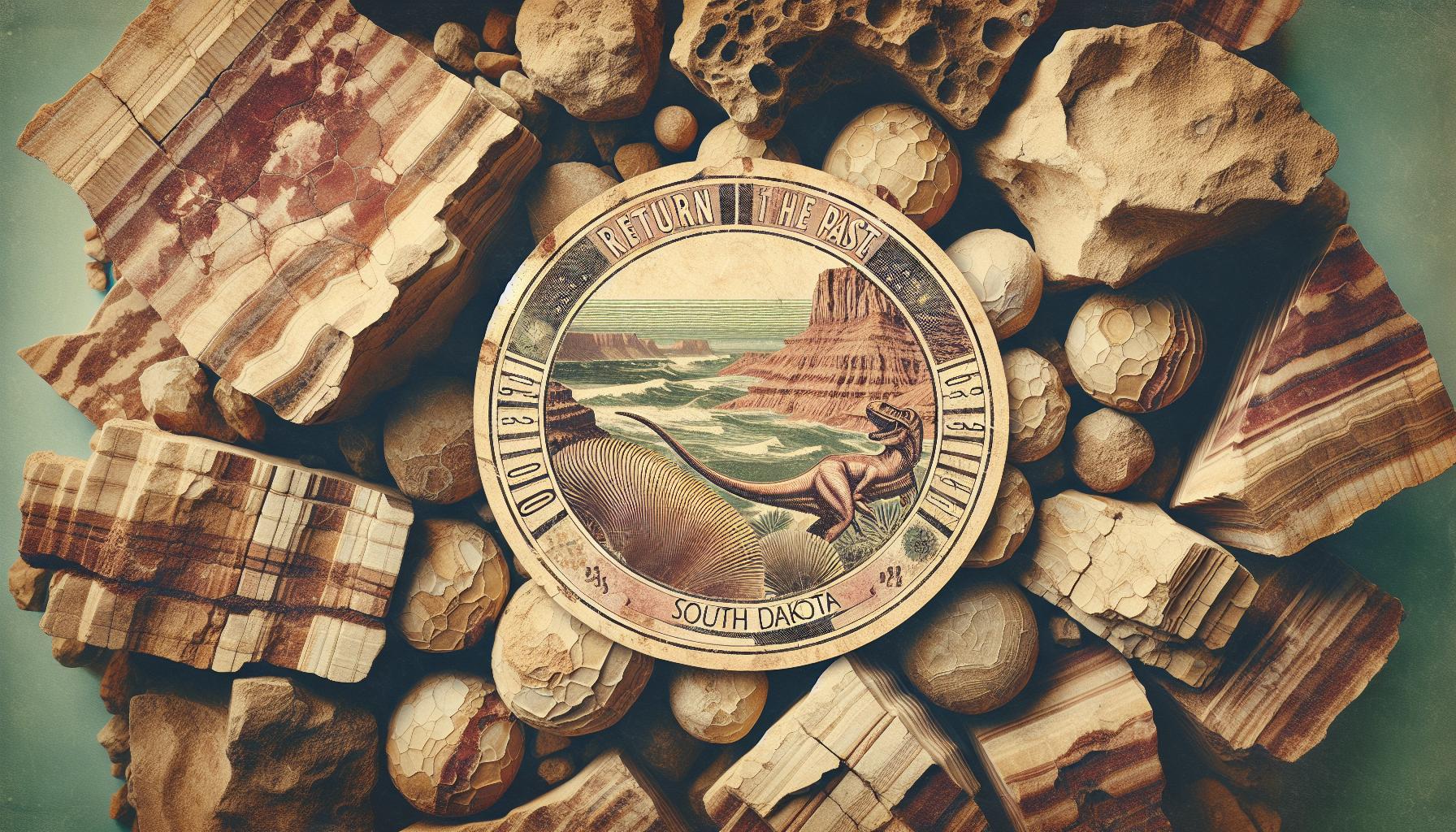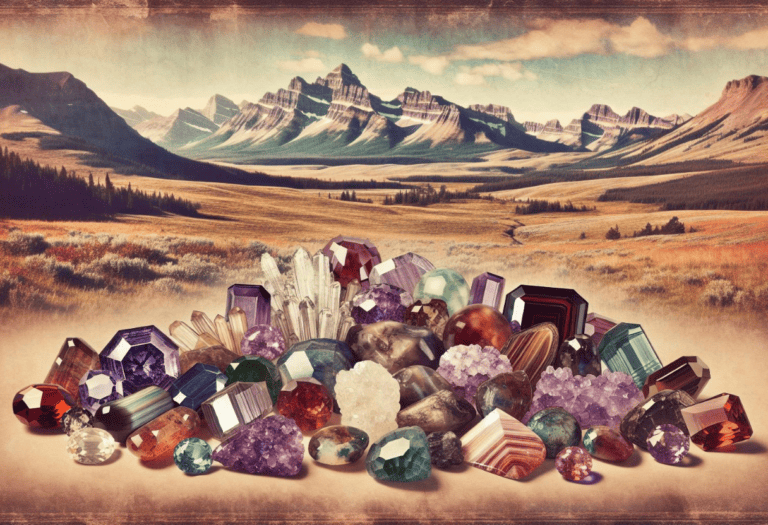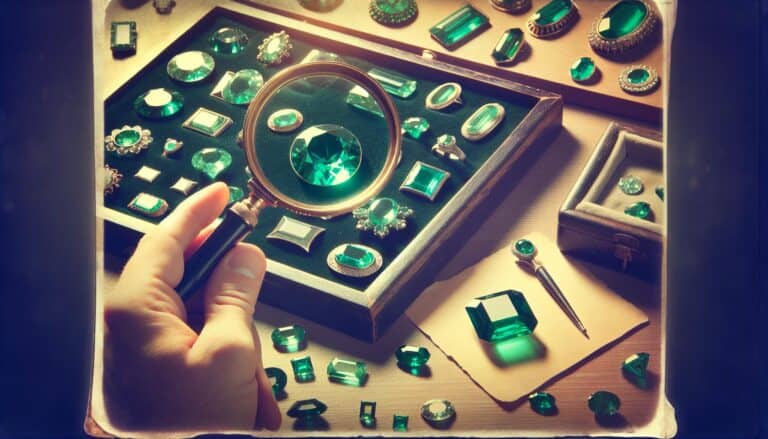South Dakota’s rugged beauty isn’t just for postcards—it’s a rockhound’s paradise waiting to be explored.
With its rich geological history, you’re set for an adventure that could end with pockets full of treasures.
From the famous Black Hills to the Badlands, you’ll discover a variety of minerals, fossils, and gemstones. Imagine unearthing your own fairburn agate or finding a prehistoric relic; South Dakota’s terrain offers these and more.
Whether you’re a seasoned collector or a curious beginner, the state’s diverse sites cater to all levels of enthusiasm.
Get ready to dig into the ultimate guide to rockhounding in South Dakota, where nature’s hidden gems are yours for the taking.
South Dakota, rich in geological wonders, offers diverse rockhounding sites. Key locations include the Black Hills for quartz and pegmatites, and the Badlands for marine fossils. Discover Fairburn Agates near Custer, beryl and spodumene in pegmatite-rich Alstead, and quartz crystals at Rye Beach.
South Dakota Rockhounding Locations
When you set out on your South Dakota rockhounding adventure, you’ll find a plethora of sites brimming with geological treasures. The Black Hills are synonymous with a rich bounty of minerals, and it’s here you’ll unearth everything from rose quartz to fairburn agates. In particular, the area around Custer is renowned for its pegmatite minerals, which include beryl and spodumene.
Venturing into the Badlands region, you’re transported into a landscape that’s ideal for finding ancient marine fossils and even dinosaur bones. This stark terrain, while challenging, rewards the persistent rockhound with incredible finds that tell of South Dakota’s prehistoric past.
Here’s a snapshot of top spots for rockhounding in South Dakota:
- Black Hills National Forest: A prime location for public rockhounding, offering quartz and a variety of pegmatites.
- Badlands National Park: While collecting is not allowed within the park, surrounding areas are a hotspot for fossil hunting.
- Bear Mountain: Accessible for a chance at discovering agate and jasper.
- Wind Cave National Park: Known for calcite boxwork, though collecting within park boundaries is prohibited.
Remember, when rockhounding, it’s imperative to stay aware of land ownership and always obtain permission if you’re venturing onto private property. Research specific site regulations as some public lands may have restrictions on collection types and quantities.
Additionally, certain locales may be more suited to those with experience due to terrain challenges or the need for specialized equipment. However, don’t let this deter you; South Dakota has locations that cater to every level of rockhound. The state’s Visitor Centers and multiple rockhounding clubs are excellent resources to help guide your journey and provide insider tips to enhance your collecting experience.
What Gemstones are Found in South Dakota?

In your quest for hidden treasures beneath the South Dakota earth, you’ll uncover a trove of gemstones that excite both beginner hobbyists and experienced collectors alike. You’re likely already intrigued by the state’s geological variety, but the specific gems available will capture your imagination even more.
Fairburn Agate, the state’s official gemstone, holds a revered spot in rockhound lore. This unique, banded form of chalcedony is a colorful testament to South Dakota’s volcanic past, exhibiting a spectrum of earth tones that make each find a natural work of art. Not surprisingly, the hunt for Fairburn Agate is competitive, so bring your patience and a keen eye.
Next on the list is Rose Quartz. South Dakota offers some of the finest specimens, which are sought after for their distinctly pink hue – the result of trace amounts of titanium, iron, or manganese. Whether you’re looking to create stunning jewelry or simply add to your mineral collection, Rose Quartz from the Black Hills should be on your radar.
But that’s just the beginning. Here’s what else you can discover:
- Beryl: This mineral family includes aquamarine and emerald, known for their delicate colors and clarity.
- Spodumene: Source of the gemstone kunzite, with its striking pink or lilac shades.
- Garnet: Typically deep red but can range in color, perfect for a dazzling piece of jewelry.
- Jasper: An opaque variety of quartz presenting in earthy reds and browns.
As you explore the rich lands of South Dakota, these treasures are not only remnants of the geological forces that shaped the region but fascinating pieces of natural art. Armed with the knowledge of what lies beneath the rugged landscape, you’re more prepared to start your rockhounding adventure.
Remember to always verify the legal status of the lands you’re exploring. Many prime rockhounding locations are on public lands where collecting is prohibited without proper permits. Check with local authorities or land management offices before you venture out with your pick and shovel.
What Sedimentary Rocks You Can Find in South Dakota?

When you’re trekking through South Dakota’s geological playground, keep an eye out for the fascinating variety of sedimentary rocks. The state’s history is literally layered into these stones.
The renowned Pierre Shale is a deep marine sedimentary rock formed during the Late Cretaceous Period. It’s notorious for fossils of ammonites, baculites, and mosasaurs. You may also stumble upon the distinctive red beds of the Minnekahta Limestone, primarily composed of shallow marine deposits that speak volumes about the prehistoric environment.
Sandstone and limestone formations are widespread, particularly in the Black Hills area. These sedimentary rocks are the building blocks of the region’s picturesque landscapes and reveal clues about ancient rivers and lush, swampy areas that existed long before humans walked these parts. In these formations, you can find remnants of prehistoric life such as plant fossils and skeletal remains of sea creatures.
Yellow Mounds, found in Badlands National Park, are an eye-catching feature due to their color. These rocks were deposited as ancient soils and are recognized for their distinctive hues, a result of varying oxidation states of iron minerals.
Keep your eyes peeled for concretions, curious geological formations often found within the sedimentary layers. These can vary significantly in shape and size and are known to contain surprises like fossils or crystals on the inside.
In terms of collectible minerals, you might encounter materials like:
- Gypsum
- Halite
- Selenite crystals
It’s essential to respect the natural and cultural heritage of these sites. Always ensure you’re collecting responsibly and legally.
As you scour these lands, note the fascinating inclusions and textures that make sedimentary rocks a collector’s delight. From ripple marks reflecting ancient currents to cross-bedding that unveils the direction of prehistoric winds, each rock tells a story millions of years in the making.
What Metamorphic Rocks are found in South Dakota?
As you delve into the geological treasures of South Dakota, you’ll find that the state is also home to a variety of metamorphic rocks. Metamorphic rocks are those that have been transformed by extreme heat and pressure from their original form into new types of rock with distinct characteristics.
In the Black Hills region, Schist can be predominantly found. This metamorphic rock is identifiable by its foliated texture, meaning it has a layered appearance. Schist found here is often rich in mica, giving it a shiny luster that can be quite striking when discovered.
Slate is another metamorphic rock present in South Dakota, though it is less common than schist. Originally shale, slate has been compressed and heated to create a fine-grained, foliated rock. It’s well-known for its use in roofing materials but also holds interest for rockhounders due to its smooth texture and variety of colors.
Quartzite, formed from the metamorphosis of quartz sandstone, is another gem you may come across. It’s highly resistant to weathering, which is why it prominently forms ridges and high points in the terrain. The quartzite in South Dakota is typically light-colored, but iron oxide can give it streaks of pink or red.
Gneiss, with its striking banded appearance, is another metamorphic rock to look out for. It forms under high temperatures and pressures that are sufficient to form new minerals but not melt the rock. Gneiss is notable for its alternating layers of light and dark minerals, which make it particularly sought-after by rock enthusiasts.
The presence of these metamorphic rocks is a testament to the dynamic geological processes that have shaped South Dakota’s landscape over millions of years. Keep in mind that identifying these rocks requires close inspection, as their features can be subtle and easy to confuse with other types.
Remember, while the thrill of discovering these metamorphic treasures is undeniable, always verify access rights and regulations before rockhounding. With responsible practices, you can enjoy the pursuit of South Dakota’s geological wonders for a lifetime.
What Igneous Rocks can You Find in South Dakota?
Delving into the igneous rock varieties found in South Dakota, you’ll be intrigued by the diversity. Pegmatite, a coarse-grained igneous rock, is particularly prevalent in the Black Hills. Pegmatites are known for containing large crystals and, occasionally, rare minerals that catch the eye of rockhounds from around the world.
In the Harney Peak Granite area, you can discover another type of igneous expanse. A notable fact about this granite is that it is part of the core that makes up the Black Hills uplift. Here, you can find:
- Large feldspar crystals
- Quartz
- Mica
This area is especially renowned for its naturally irradiated Smoky Quartz crystals, which boast a unique dark coloration due to exposure to natural gamma rays.
Heading towards the Bear Mountain region, you can explore rhyolite outcrops. Rhyolite is an igneous volcanic rock that is fine-grained and often pink or gray in color. Its appearance is marked by the flow structure created during the cooling process.
Basalt, another common igneous rock, can be found in the ancient lava flows of the state. Basalt formations in South Dakota are mostly confined to the western regions and vary from compact to vesicular textures. Among these formations, you may also find pockets lined with Zeolites, a group of minerals that are highly sought after for their crystalline structures and water-cleansing properties.
When rockhounding for igneous rocks in South Dakota, always be aware of the rock’s surroundings. Many of these specimens exist within protected areas, and collecting rocks could be subject to strict regulations. Always research ahead and ensure you’re in compliance with local laws. Remember that the natural beauty of these igneous formations contributes significantly to South Dakota’s geological allure and needs to be preserved.
Panning for Gold in South Dakota
South Dakota is steeped in gold mining history. The Black Hills Gold Rush began in 1874, and today, you can still channel your inner prospector. Gold panning is a popular activity for visitors who want to experience the thrill of discovery.
When you’re ready to try your hand at panning, the Black Hills are your go-to destination. Responsible gold panning is allowed in several streams and rivers within the region under certain conditions. Ensure you use non-motorized equipment as motorized mining tools are prohibited without a permit.
Here’s where to go:
- Rapid Creek is accessible and has been a favored spot for generations. Panning here might reward you with small gold flakes.
- At Spearfish Creek, near the town of Spearfish, you can pan in a picturesque setting.
- Castle Creek and French Creek are also known for occasional gold finds.
Remember to respect private property and only pan in areas open to the public. The rules can vary greatly depending on whether the land is state-owned, federal, or private.
Safety Considerations and Environmental Impacts: While panning, it’s crucial to be mindful of the environment. Don’t disrupt the riverbeds or local wildlife habitats. Always refill any holes you dig and stay clear of areas that are ecologically sensitive.
For a historical panning experience, visit the Wade’s Gold Mill in Hill City, where you can learn about the gold mining history of the area and pan for gold in a controlled setting.
Legal Requirements: Before you start panning, check current regulations. You may need to obtain a mining permit or landowner permission. The South Dakota Department of Environment and Natural Resources is a good resource for the latest information on permits and guidelines.
Rockhounding and panning in South Dakota offer a tangible connection to the history and geology of the region. With careful planning and respect for the land, you can enjoy the excitement of discovering nature’s treasures in one of America’s most storied gold mining areas.
Rocks and Minerals Found in South Dakota
When exploring the diverse geological landscapes of South Dakota, you’ll discover a treasure trove of rocks and minerals. Fairburn Agate, the state’s official gemstone, is a prized find for any rockhound. Cut and polished, these agates reveal intricate patterns, making them perfect for jewelry and display pieces.
Apart from Fairburn Agate, South Dakota is chock-full of quartz varieties. You can find:
- Clear quartz
- Smoky quartz
- Rose quartz
- Amethyst
These quartz specimens, especially the coveted amethyst geodes, are found throughout the Black Hills. Patience and a keen eye can lead to impressive additions to your collection.
The badlands harbor a host of fossils and minerals. Petrified wood and fossils of ancient creatures emerge from the eroded landscape. Mineral collectors might also uncover gypsum and calcite.
For those interested in more metallic minerals, the Black Hills are historically known for mica and spodumene. While gold panning captures the imagination of many visitors, remember that exploring for minerals can be equally rewarding.
| Mineral | Common Locations in SD | Notes |
|---|---|---|
| Agate | Fairburn, Badlands, Black Hills | State gemstone, banded patterns |
| Quartz | Throughout the Black Hills | Includes varieties like amethyst |
| Fossils | Badlands | Remains of ancient life |
| Mica | Black Hills | Metallic mineral often in sheets |
| Gypsum | Near surface in the Badlands | Can form large crystals |
| Spodumene | Black Hills | Source of lithium, often in pegmatites |
Keep in mind that responsible rockhounding is key. It’s not just about what you find but also how you find it. Always obtain landowner permission and adhere to local regulations. Remember to pack out what you bring in, leaving the stunning natural areas of South Dakota as pristine as you found them.
Where Can I Find Fossils in South Dakota?
Curiosity about the past often drives rockhounds to seek out fossils, the preserved remains of ancient life. South Dakota, with its vast and varied geological landscape, is a hotspot for discovering such remnants. While you explore, keep in mind that collecting fossils on public land is subject to strict regulations, so be sure to familiarize yourself with local laws.
The Badlands National Park is one of the most fertile grounds for various fossil finds. Although recreational collecting is not permitted within the park, you can still marvel at the well-preserved fossils on display. For a more hands-on experience, the visitor center offers educational programs where you can learn about fossil identification and preservation.
Outside of protected areas, the Hell Creek Formation, exposed in parts of South Dakota, is renowned for its late Cretaceous fossils. You’ll find opportunities to dig for fossils such as:
- Triceratops bones
- Hadrosaur pieces
- Fossilized plant material
Private fossil hunting tours in this region allow you to search with guidance, thereby reducing the environmental impact and increasing your chances of a significant find.
If your interest leans towards marine life, the Pierre Shale Formation could be your target destination. This site is less popular than the Badlands but yields exquisite fossilized ammonoidea and baculites. Remember, obtaining fossil collection permits is necessary when planning to visit certain fossil-rich sites.
South Dakota also boasts the familiar Fairburn Agate grounds, which, aside from their famous agates, occasionally turn up fossilized shells and plant impressions within their strata. Farm and ranch lands often contain fossil beds; however, always obtain the landowner’s permission before exploring these private properties.
South Dakota Rockhounding Laws & Regulations
When you’re planning a rockhounding trip in South Dakota, it’s crucial to be well-informed about the local laws and regulations to ensure your adventure complies with the rules. Permission is key; always seek permission before collecting on private land, as failing to do so can result in legal repercussions.
Public lands offer various opportunities but come with a set of guidelines. The U.S. Bureau of Land Management (BLM) permits the collection of reasonable quantities of rocks and minerals for personal use. However, there are limits to what you can collect, typically no more than 25 pounds plus one piece per day, with a yearly cap of 250 pounds. It’s important to remember that commercial collecting requires a separate permit.
State Park rules vary, so check the specific regulations of the park you plan to visit. In general, though, removal of any natural materials from State Parks is typically prohibited. This includes rocks, minerals, and fossils. Make sure you’re not accidentally infringing on these regulations.
While South Dakota is generous with offering places to explore, certain areas are off-limits. National Parks, for instance, have strict no-collection policies to preserve the natural history and beauty of the areas. In these places, you’re invited to look, photograph, and enjoy, but leave all natural objects undisturbed.
When it comes to Tribal lands, which hold historical and cultural significance, always respect the area and adhere strictly to the rules. The best practice is to contact the local tribe or governing body beforehand to obtain explicit permission to collect rocks or fossils.
Finally, familiarize yourself with the South Dakota Paleontology Resource Act if you’re interested in fossil collection. This act requires permits for collecting fossils on state and school lands and lays out clear guidelines for protecting paleontological resources.
Make sure to carry a copy of the regulations and permits you need during your rockhounding excursions. This preparedness will not only ensure you’re acting within the law but also contribute to the conservation efforts for future generations of rockhounds.
Rockhounding Tips for Beginners in South Dakota
Gearing Up: Essential Tools for Rockhounding
Before you head out to scour South Dakota’s terrain for gems and minerals, it’s vital to equip yourself with the right tools. Building a beginner’s kit doesn’t have to break the bank, but it should include some basics:
- Rock hammer: A must-have for breaking rocks and prying specimens from the earth.
- Chisel: To help you extract your finds without damaging them.
- Safety goggles: Protecting your eyes from flying rock chips is non-negotiable.
- Gloves: Durable gloves will shield your hands from sharp edges and rough surfaces.
- Bucket or backpack: You’ll need something to carry your treasures in.
- Field guide: A good guidebook can help identify the rocks and minerals you find.
- First aid kit: Always be prepared for minor injuries.
With these essentials, you’ll be ready to start rockhounding.
Safety Tips While Rockhounding
Your safety should always be your top priority. South Dakota’s varied landscape can be rugged, so follow these safety tips:
- Stay hydrated: The state’s climate can be dehydrating; carry plenty of water.
- Wear appropriate clothing: Long sleeves and pants protect against sunburn and scratches.
- Let someone know where you’ll be: Especially if venturing into remote areas.
- Be weather-wise: Sudden changes in weather can create hazardous conditions.
- Watch for wildlife: South Dakota is home to both poisonous and benign creatures.
- Use tools properly: Mishandling rock hammers and chisels can cause injury.
By taking precautions, you reduce the risks and enhance the enjoyment of your hunt for geological wonders.
Legal Guidelines for Rockhounding Enthusiasts
Understanding and following the legal guidelines for rockhounding is crucial. Here’s what you should keep in mind:
- Land ownership: Always determine the ownership of the land you’re exploring. If it’s private, seek permission.
- Collection limits: Public lands may have rules about how much material you can collect.
- Protected areas: Some areas may be off-limits for collecting due to their ecological or historical significance.
For specifics, refer to the Bureau of Land Management or the South Dakota Geological Survey. Remember, regulations are in place to preserve South Dakota’s rich geological heritage for future generations.
Conclusion: South Dakota Rockhounding Locations
Armed with the right tools and knowledge, you’re all set to embark on your rockhounding adventure in South Dakota.
Remember to prioritize your safety and adhere to legal guidelines to ensure a responsible and fulfilling experience. With the state’s rich geological offerings, you’re sure to uncover some incredible finds. Keep exploring, stay safe, and treasure the natural beauty that South Dakota’s landscapes provide.
Happy rockhounding!







